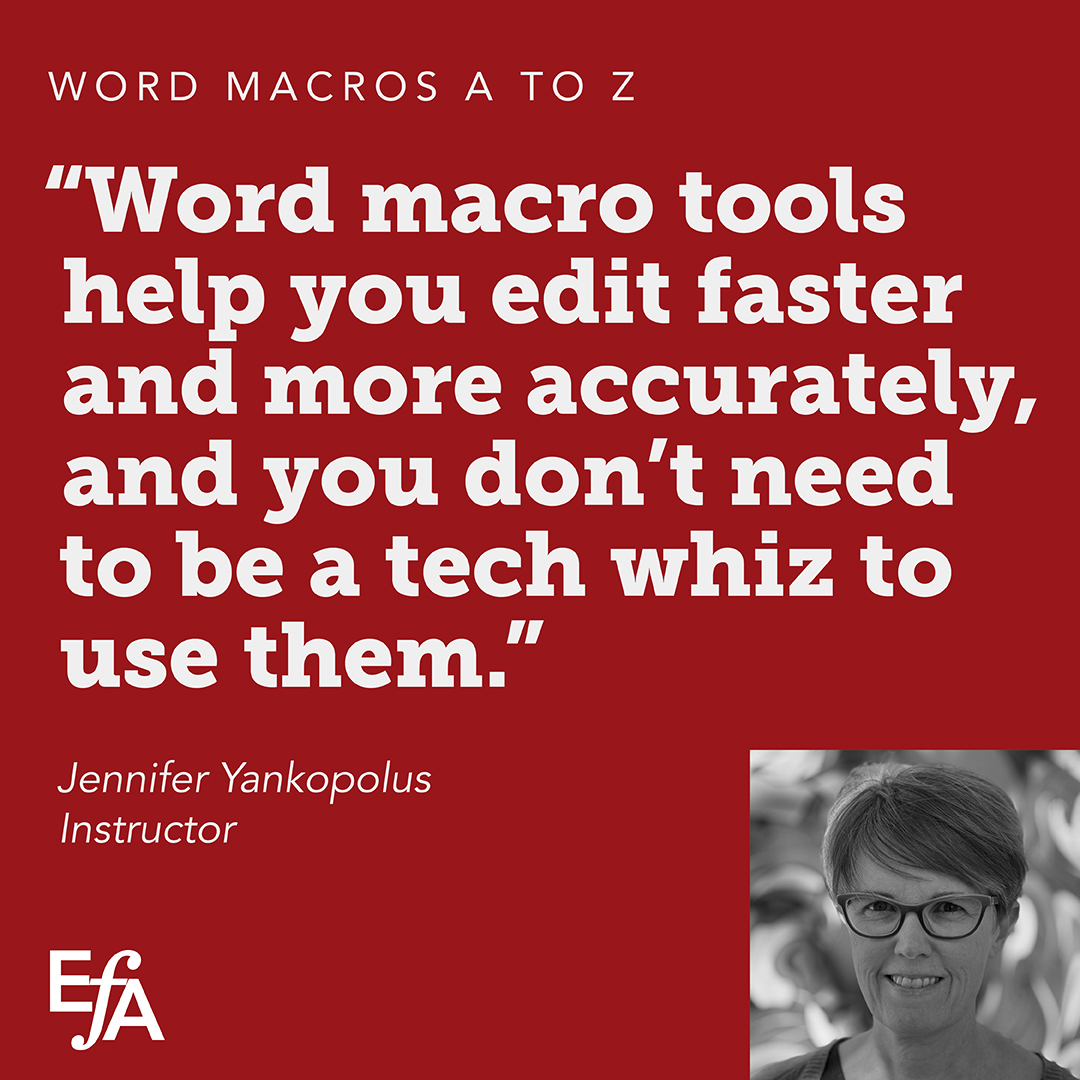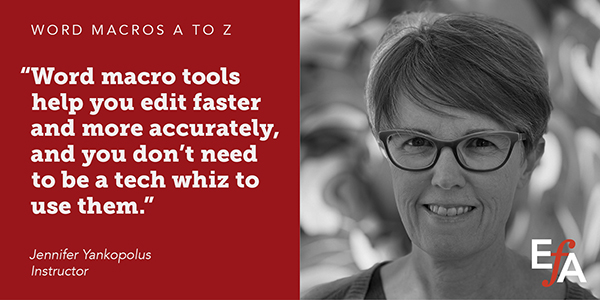Description
Our courses are asynchronous, meaning you never need to be at your computer at any specific hour. More information about how these classes are conducted is available here.
After placing your order, your course will be added to your personal course library on our education site. That site has different login information from the main EFA site. Please check your email for information on how to access the course.
If this session is full or the dates don’t work for you, join the waitlist to be informed of last-minute openings and future sessions.
Want to edit more efficiently while reducing repetitive strain? Word macros are free tools for Microsoft Word that automate routine editing tasks on both PCs and Macs. These time-savers help you find consistency errors, fact-check, and handle repetitive editing tasks more quickly and accurately.
This course takes the mystery out of macros, breaking them down into manageable, understandable segments. Through step-by-step instruction, you’ll learn the essential technical skills needed to use macros and gain hands-on experience with real-world editing scenarios. For those who have experience with macros or are ready to dive deeper, the course includes an optional intermediate lesson each week.
Using macros requires only basic computer skills—if you can copy and paste, you can use macros. The course focuses on Paul Beverley’s extensive library of prewritten macros, so no programming knowledge is required.
- Week 1 covers how to install macros and assign them shortcuts and how to use macros to speed up copyedits.
- Week 2 teaches you how to navigate the catalog of 1,200 preprogrammed macros and how to use macros to fact-check using Google, dictionaries, and other online searchable databases.
- Week 3 shows you how to insert comments, including standardized comments, using comment macros, and how to use macros to help you find inconsistencies, such as in the spelling of proper nouns.
- Week 4 demonstrates HighlightWordList to help you catch common mistakes, such as easily confused words, jargon, redundancies, and filler words. It also covers MultiSwitch, a text-switching macro that corrects situational mistakes, including text flagged by HighlightWordList.
- Week 5 explains how to use the powerful FRedit macro, a global find-and-replace macro that applies global style spelling, punctuation, and style conventions, and performs other time-saving tasks.
- Week 6 concludes with creating a macro workflow plan for incorporating macros into your existing editing process, including with other editing software, and goes over how to improve your efficiency sustainably.
Note that the course does not cover how to record or program macros.
Expect to spend approximately 1.5–2 hours per week on the course. (Week 1 will require slightly more time, as the material is a prerequisite for the rest of the course.) Written lectures provide an overview of each week’s material, and videos demonstrate how to use the macros being covered. You will practice each week’s set of macros using real-world editing scenarios; all materials will be provided. The instructor will be on hand throughout the course to assist you via the discussion forum and three Zoom Q&A sessions (scheduled during the first week with student input on timing).
This course helps you work smarter, not harder. You’ll learn how to streamline repetitive tasks, catch more errors, and create efficient editing workflows. The flexible format accommodates both quick learners and those who prefer a slower pace. Whether you work on journal articles, book manuscripts, marketing materials, or other Word-based text, by the end of the course you’ll have a customized set of macros tailored for your specific editing needs.
Required materials:
- Microsoft Word 2010 or newer (PC or Mac)
Our students say…
Thank you for such a wonderful course! I had tried using Paul’s macros before, but it was really overwhelming and difficult to know where to start. This course was exactly what I needed! —B.A.M.
Great format to learn macros at a reasonable pace. I love that it had a structure, but also could be a bit self-paced for when things get busy and you fall behind. —A.S.
I would absolutely recommend this course to colleagues. It was so beneficial to my efficiency and effectiveness at work. —O.S.
This course is open to students at all levels.
Jennifer Yankopolus (she/her) has been editing in the architecture and design field for 25 years and is an instructor in the University of California, San Diego Copyediting Certificate Program. Since 2020, she has been teaching editors worldwide how to use macros to increase their productivity. Besides teaching the Word Macros A to Z course, she regularly leads webinars and workshops around the world to train editors how to edit more efficiently by using macros. To support editors in their ongoing use of macros, she writes the Macro of the Month newsletter, which introduces readers to one new macro each month and provides practical tips.



